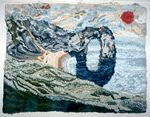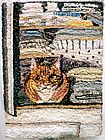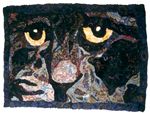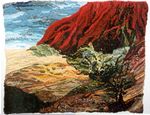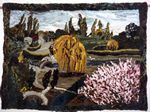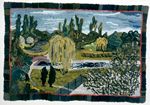![]()
Louisa
Creed’s Approach to Rag Rug Hooking
Louisa Creed is an English woman in her early sixties, living in the historic city of York, known for its Roman wall, its ancient buildings and streets, its magnificent cathedral (known as the Minster) and its periodic, devastating flooding. I am Louisa’s husband, Lewis, white-bearded and enthusiastic. So enthusiastic, indeed, that the rug-hooking occupation has gripped me, too, and we sit together in our little end-terrace house on the edge of a park, happily hooking in the evenings. Louisa is a flautist too, and I help her to “manage” her life, that is to say her concerts and exhibitions, as she needs support with the public side of things.
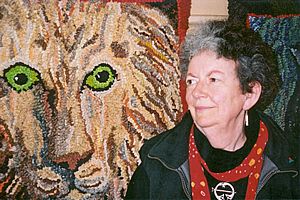 |
|
Photo:
Herbert Whone
|
Louisa began rug-hooking about 13 years ago. She saw some early rag rugs in a folk museum and wondered why they weren’t still a part of our tradition. “I would like to make some” she said, oblivious of the fact that a rag rug revival was already in its infancy in England. It never occurred to her to try to contact other people with the same idea, so she simply found an old latch hook, bought some hessian and cut up a few old clothes. She says she will never forget her first essays, the first few loops, then another row and then another, building up a fabric and thrilling to the effects of colour and texture. She now says that in some ways she is glad that she is self-taught and made all her own discoveries, even though her craftsmanship may not be of supreme neatness. She was able, in her own way and in her own time, to “feel” her way to her present technique. American rug hookers would call her work “primitive” because she cuts her rags (with scissors) thick, ie approximately one to three inches, and it is the resultant coarse texture that she delights in.
I should, perhaps, explain that Louisa was raised in a family of painters, and the visual impressions she absorbed from an early age are certainly reflected in her whole approach to rag rug hooking. While her musical career was in full flow, her painterly instincts were dozing. This partly explains Louisa’s having taken to working with rags as to a clap of thunder!
She uses a traditional rag rug hook, loose-weave hessian and entirely recycled clothes, her favourite materials being jerseys – not too thick and very often patterned – T-shirts, stretchy velvet clothes, and anything with a degree of elasticity. We frequent jumble sales and charity shops. She chooses; I carry home and pay; she washes, “fillets” and rolls, stores and dispenses; we each cut our own strips. Louisa is the experienced one, as she was working with rags for ten years before I became hooked, but I have found my own style now, and need her guidance less and less. I cut my strips thinner than she does and therefore my technique is finer, neater. I have learned to mix my colours, but very differently from the way she does. My choice of colours is quite haphazard, but Louisa waits for a bright day to choose hers with great care. (She always examines a garment in daylight before purchasing it from a charity shop). She likes to have a large store of colours which is a big problem in a small house. (Out go her clothes to make more room for rolled, filleted garments.) The larger the store, the greater the choice and the more colours she can use in a given area. For example, a patch of sky would require for her, a palette of about twenty blues whereas most people would be content with 4 or 5. She enjoys mingling very close-toned colours, which, she says, invite the eyes to explore and keep exploring. The size of her rugs, which can be used on the floor but are more often wall-hangings, varies – her largest measuring about 5 foot by 4, and the smallest 3 by 3. She also makes smaller articles such as tea cosies and cushion covers.
Louisa doesn’t make to sell, but when people fall in love with her work she parts with it quite willingly, partly because the house tends to fill up with her rugs, and now with mine too! She uses old sheets for bags in which she stores them in a cupboard in the converted roof space, and here, too, she keeps bags of rags and hessian. She uses velcro to secure them on to battens for hanging, and in this way the battens can be ripped off if the rugs are to be used on the floor. We have no studio. The nearest we get to one is the bay window recess behind the sofa in our sitting room. This works very well – we just toss everything over the sofa when Louisa needs the room for teaching the flute, rehearsing for concerts or entertaining.
Louisa designs all her own rugs. Almost anything can trigger off an idea: a view, a photograph or post card, a conversation, an experience and particularly cats and travels. She became well-known in the rag rug world for a cat design called “Rosie in the Airing Cupboard”. In England our houses nearly always have a warm cupboard above the hot water tank, with slatted shelves where we keep our linen and air our clothes after washing and drying outside on the line. This was a favourite haunt of our ageing cat, Rosie, and the sight of her looking so cosy (and also slightly guilty) was the inspiration for this, her very first pictorial rug. By chance this was included in a book called Rag Rugs of England and America by Emma Tennant (Walker Books) and gave rise to some of Louisa’s other rugs being included in further books on rag rugs, such as Rag Rug Inspirations by Juliet Bawden (Cassell), Rag Rugs by Juju Vail (Apple) and Artists as Rugmakers compiled by her brother, Tim Nicholson, to accompany a Crafts Council touring exhibition, published by The Boveridge Press in 1994 and obtainable from Louisa (£6 including postage and packing).
Apart from this exhibition, which toured widely in the UK, Louisa has shown her rugs in galleries, halls, theatres and chapels all over the country. She is best known for her cats, but also enjoys hooking other subjects such as birds, landscapes and still lifes.
Click on the images
to see a larger picture
She has hooked several rugs of Rosie, and also many other cats. Three of her cat designs are of enormous close-up heads; one of these is entitled “Mouse-Eye View” and depicts a somewhat alarmingly close detail of eyes, nose and mouth from the safety of a mouse-hole. Another of her cat rugs is called “12 Cats” and in this design the hessian is divided into 12 squares, with borders, and from each square a cat’s face regards the observer. The cats are all quite different in colour and facial expression. Louisa also likes to make tea cosies with a cat’s face on each side, and cushions (“catter cushions!”).
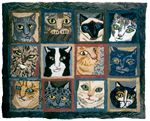
12 Cats
1998
A recent trip to Australia inspired Louisa’s largest landscape “Ayer’s Rock” (5' x 4') which has attracted a lot of attention. The number of colours used is very large, but these are blended in such a way as to be deep and subtle rather than garish. “Lizards of Oz” was another direct result of her antipodal travels, inspired by Aboriginal paintings. Another idea, this time from New Zealand, has been longing to find expression, and this Louisa is just about to embark on – a large aerial view of volcanic craters – some of them filled with astonishingly turquoise water, rimmed with green. She took photographs while soaring over them in a small plane, and all the time she was filled with wonder and exclaiming “rag rug!” The little plane would dip and glide; another amazing sight would unfold as we crossed a gleaming ridge, and all the while Louisa was holding her breath and wondering whether such an extraordinary visual experience could be conveyed in rags! A real challenge for the immediate future. Louisa has already prepared the hessian – that is to say cut if off the roll and hemmed the edges which she irons first. (She works right up to the edges and doesn’t back her rugs.) However, this is a future rug, and I will tell you about more of the ones she has already made!
Click on the images
to see a larger picture
One that stands out, for me, is “Lewis and Louisa Making Rag Rugs”. She suddenly had the idea that she would like to do a double portrait of us both, beavering away, sitting at right angles to each other on a sofa and a wing chair, our rugs on our laps. Now, although drawing in her family was a natural part of childhood, she never had any formal art training, and considers herself a little shaky when it comes to drawing on the hessian. She makes a sketch first and transfers it directly to the hessian. She used to square up her drawings on the pad, and then on the hessian, but found the mathematics very troublesome, so now simply does it quickly, by eye with a thick black felt pen. In this particular case she was trying to get a likeness, too, and succeeded to a great extent, as people never fail to recognise us! The whole effect is somewhat naive because the perspective is a little dubious, but nevertheless it has proved a very popular rug. She didn’t use photographs. Generally she doesn’t copy anything but her own drawings, and even these she abandons after the first few tentative strokes. She finds a blank hessian surface frightening, and begins faintly, but as she progresses she is encouraged and her strokes become blacker and more sweeping. She considers it important to get a flow going at the drawing stage, and then tries to keep very closely to the outlines when hooking.
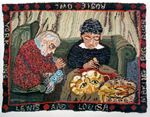
Lewis and Louisa Making Rag Rugs
1999
Louisa very much enjoys using rags to imitate stone. She has hooked two rugs representing our famous English archeological site, Stonehenge. She collected stone colours for a long time before so that she could get delicate gradations of light and shadow on stone, making the columns look as solid and as 3-dimensional as she could. Somehow, she says, the coarse texture of roughly cut woollens, cottons, man-made fibres and velvets lend themselves particularly well to stone. Another of Louisa’s projects has been to make a drawing of the view of the park from our attic window, and to hook four rugs from the same drawing – one for each season. She worked on the appropriate ones as the seasons came round, studying the changes in colour, form and light. Each measuring approximately 5' x 3'2", unfortunately they are very rarely shown together as they take up so much wall space.
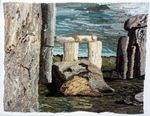
Stonehenge
1998
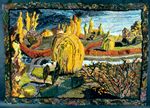
In England there are many charity shops recycling clothes and all kinds of items at very reasonable prices. They have improved enormously in the last few years. They are well-run little businesses with ordered racks of clean clothes, no longer smelling of tobacco, mothballs and grime. We can’t resist them. Louisa is always on the look-out for woollen articles of unusual colour, and she is quite willing to deviate from the bargain rails for such a prize. Very often we try them on when they emerge from our own washing machine, and if we like them we wear them for a bit, until they are required urgently for a rug. We never buy new clothes these days, and yet our wardrobes are constantly changing!
Rag rug making has become a way of life for us, to the amusement of some of our friends. To us it seems a natural and endlessly fascinating orientation to the texture of daily living.
Louisa gives workshops from time to time, although she never advertises her services in this respect, and will not even consider it unless assisted by me and a friend, as we work as a team and thoroughly enjoy imparting what we have learned to eager beginners. Glenda, our friend, has developed an entirely different style from either of us. Although she is American-born, her rugs are far more “primitive” than ours! Using a latch hook, she pulls great thick, tall loops through the hessian and mixes her colours in a rich and very individual way. It is instructive to beginners, we feel, to show them our very different techniques and approaches. Louisa holds that there are no rules in rag rug making. Each student, with time, patience and enthusiasm, will come into his (or more likely her) own style. A particular way of hooking, an individual imagination and a good colour-sense, will find a way to express itself in each person if given the chance. People who say they cannot draw can begin with a simple diametric design and “feel” their way into the art form in that way. She thinks it is partly a question of “being passive to the materials” ie allowing the fabrics to suggest how a rug is to progress. One may begin with a definite idea, but find that it doesn’t work out in the way envisaged. Instead of trying to force the materials to conform to an idea that may not suit them, one “listens” to what they suggest, and they lead you into places you never dreamed of.
Another piece of advice from Louisa is: all rugs look messy and totally unpromising in the early stages. Keep going. Don’t unpick anything – everything changes as you progress. You simply can’t tell until nearly the end whether something will work or not. Sometimes, if you can resist the temptation to pull it out, an offending bit becomes a strong point in the final result.
Louisa belongs to a small group of friends who meet informally in each other’s houses on Wednesday mornings. This is a time for the exchange of experiences, ideas and colours (One of their members even cut a sleeve off a jumper she was wearing to oblige another who had remarked that the colour was just right for her sunset!). Occasionally they hold exhibitions of their work in a York chapel, manning it on a rota system and inviting visitors to sit and join them if they already make rugs, or learn how to hook if they don’t. The space is large, light and airy, and we use long trestle tables, and tea-making facilities, and sell cards, hooks and small rolls of hessian. We can sell our rugs at reasonable prices because the chapel only takes 10% and doesn’t charge us any rent. We take it for 14 days, opening with a large private view.
There is also a wider, York-based group, the Ebor Ruggers, with a membership of about 50, to which Louisa also belongs. They meet once a month and organise speakers, visits and exhibitions. Each summer they invite other rag rug groups from further afield to a picnic, when everybody brings their work, finished and unfinished. It is displayed (if fine) on the grass, and, as may be imagined, it is a highly colourful occasion.
The organisers of this group would be very happy to welcome any visitors, or to correspond with similar groups from the USA. Contact: Heather Lamborn, Pond Cottage, Angram, York, YO23 3PA, UK; tel: 44 1904 738317; email: lamborns@btopenworld.com
Lewis Creed
Reproduced by kind permission of Rug Hooking (July 2001)
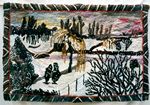
Views over
Rowntree Park
1996/7
Click on the images
to see a larger picture
RUGS
:: LOUISA &
RAG RUGS :: LEWIS & RAG RUGS :: CONTACT
CREDITS & LINKS :: HOME :: RUGS AVAILABLE FOR SALE
Louisa
Creed
York, UK, 2001-2018
